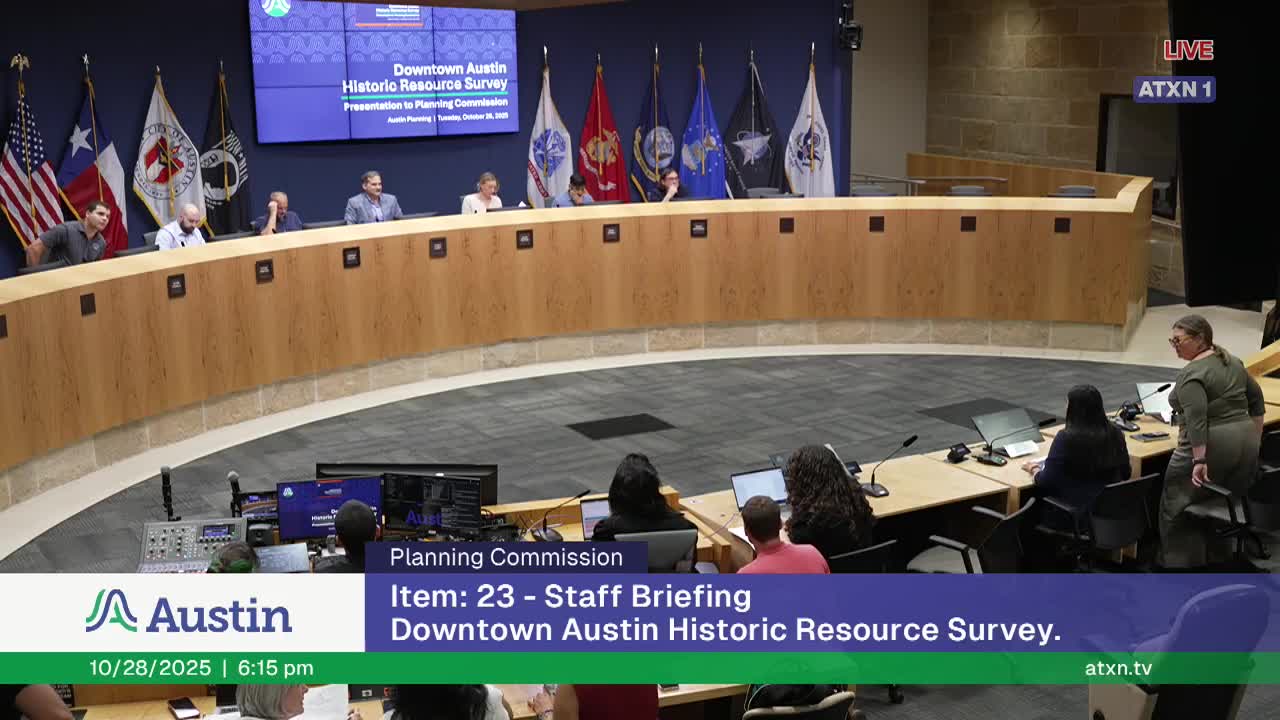City planning staff present Downtown Austin historic resource survey update
October 28, 2025 | Austin, Travis County, Texas
This article was created by AI summarizing key points discussed. AI makes mistakes, so for full details and context, please refer to the video of the full meeting. Please report any errors so we can fix them. Report an error »

City of Austin historic preservation staff on Thursday briefed the Planning Commission on a 2024 update to the Downtown Austin Historic Resource Survey, a multi-step inventory that documents buildings and structures at least 50 years old and assesses their eligibility for local or national historic designation. "Standard practice is that they should be updated every 10 years," Sofia Wagner, a historic preservation staffer, told commissioners.
The survey covered a downtown area bounded roughly by Enfield Road and MLK Boulevard to the north, I‑35 to the east, Lady Bird Lake to the south and Mopac to the west. Staff reported that the update covered 1,964 resources across 1,553 parcels, of which 982 are located within areas already listed or newly identified as eligible for historic-district designation and 275 were identified as individually eligible for landmark designation. Wagner said the work included building a geospatial database, field documentation of primary and secondary structures, photographic records and review of occupancy history and historical themes.
The work was led by the city’s Historic Preservation Office in collaboration with a local preservation consulting firm. Wagner said the survey is advisory: "If my property is part of this survey area, does this mean that it results in automatic zoning or tax changes? The answer is no," she told the commission. The survey is intended to inform staff decisions, streamline designation requests by property owners and help identify sites that matter to underrepresented communities and heritage tourism.
Staff highlighted incentives associated with local landmark or district designation, including eligibility for rehabilitation tax credits at the federal level and local tax incentives when properties are designated; they emphasized that survey findings do not by themselves change zoning. The project timeline began in December 2023, included a public feedback period in March–May 2024, and the survey was delivered to the city in June 2024 and posted online, staff said.
Commissioners asked about plans to update other areas of the city, including East Austin. Kim McKnight, division manager for historic preservation, said recent increases in funding — notably from the Historic Preservation Fund sourced from hotel occupancy tax revenue earmarked for tourism and preservation — have allowed more regular surveys and that the office hopes to prioritize neighborhoods under high development pressure. "To go 40 years without a historic resource survey in a downtown is not great," McKnight said.
Philip Wiley, a downtown resident who had filed to speak, waived his three-minute slot. Staff said they will bring future survey updates and additional briefings as the program continues.
The survey covered a downtown area bounded roughly by Enfield Road and MLK Boulevard to the north, I‑35 to the east, Lady Bird Lake to the south and Mopac to the west. Staff reported that the update covered 1,964 resources across 1,553 parcels, of which 982 are located within areas already listed or newly identified as eligible for historic-district designation and 275 were identified as individually eligible for landmark designation. Wagner said the work included building a geospatial database, field documentation of primary and secondary structures, photographic records and review of occupancy history and historical themes.
The work was led by the city’s Historic Preservation Office in collaboration with a local preservation consulting firm. Wagner said the survey is advisory: "If my property is part of this survey area, does this mean that it results in automatic zoning or tax changes? The answer is no," she told the commission. The survey is intended to inform staff decisions, streamline designation requests by property owners and help identify sites that matter to underrepresented communities and heritage tourism.
Staff highlighted incentives associated with local landmark or district designation, including eligibility for rehabilitation tax credits at the federal level and local tax incentives when properties are designated; they emphasized that survey findings do not by themselves change zoning. The project timeline began in December 2023, included a public feedback period in March–May 2024, and the survey was delivered to the city in June 2024 and posted online, staff said.
Commissioners asked about plans to update other areas of the city, including East Austin. Kim McKnight, division manager for historic preservation, said recent increases in funding — notably from the Historic Preservation Fund sourced from hotel occupancy tax revenue earmarked for tourism and preservation — have allowed more regular surveys and that the office hopes to prioritize neighborhoods under high development pressure. "To go 40 years without a historic resource survey in a downtown is not great," McKnight said.
Philip Wiley, a downtown resident who had filed to speak, waived his three-minute slot. Staff said they will bring future survey updates and additional briefings as the program continues.
View full meeting
This article is based on a recent meeting—watch the full video and explore the complete transcript for deeper insights into the discussion.
View full meeting
